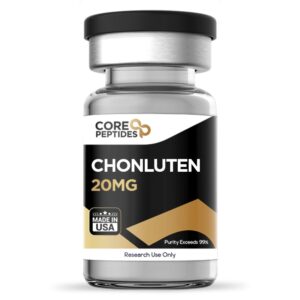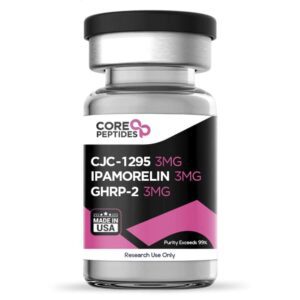Description
Hexarelin Peptide (Examorelin) – Research Overview
Hexarelin, also known as Examorelin, is a synthetic growth hormone–releasing peptide (GHRP) that has gained attention in research for its potential similarity in action to GHRP-6. Structurally, Hexarelin consists of six amino acids and belongs to a class of compounds designed to mimic the effects of ghrelin, the naturally occurring 28-amino-acid peptide known to stimulate growth hormone (GH) release and regulate appetite.
First developed over 25 years ago, Hexarelin continues to be the subject of numerous studies examining its biological mechanisms, growth hormone–modulating activity, and cardiovascular research potential.
Mechanism of Action
Researchers suggest that Hexarelin may function by binding to and activating ghrelin receptors, also known as growth hormone secretagogue receptors (GHS-Rs)—specifically GHSR-1a—found in the pituitary gland and hypothalamus.
Upon activation, these receptors may trigger intracellular signaling pathways involving G-proteins and protein kinase C (PKC), potentially leading to an increase in growth hormone secretion from pituitary cells.
This mechanism differs from the native growth hormone–releasing hormone (GHRH) pathway, suggesting Hexarelin may act through a distinct yet complementary route to stimulate GH synthesis. However, prolonged exposure has been reported to cause temporary receptor desensitization, which may persist for several days or weeks.
Biological Impact
While primarily associated with GH release, Hexarelin has also been linked to the potential stimulation of other pituitary hormones, such as adrenocorticotropic hormone (ACTH) and prolactin—though such activity is generally undesirable in experimental settings.
Beyond hormonal regulation, Hexarelin may influence appetite and energy balance through activation of ghrelin receptors in the nervous system, potentially stimulating hunger-related neuropeptides like neuropeptide Y (NPY) and Agouti-related peptide (AgRP) while reducing α-MSH secretion. These actions may increase hunger and food-seeking behavior in research models. Additionally, Hexarelin may affect the mesolimbic reward pathway, possibly influencing reward-driven eating patterns via cAMP-dependent signaling.
Chemical Information
-
Molecular Formula: C₄₇H₅₈N₁₂O₆
-
Molecular Weight: 887.05 g/mol
-
Synonyms: Examorelin
Key Research Findings
1. Growth Hormone Secretion
In comparative studies, Hexarelin was evaluated alongside GHRH and GHRH combined with arginine. Findings suggested that Hexarelin could significantly increase GH secretion, especially in adolescent and mature models, exceeding the GH release observed with GHRH alone. In older models, the peptide still demonstrated elevated GH levels, though less pronounced compared to combined GHRH + arginine administration. These results indicate Hexarelin’s potential role as a potent GH secretagogue across different stages of development. (Torsello et al., 1996)
2. Synergistic Potential with GHRH
Research involving GH1 murine cell lines revealed that Hexarelin and GHRH may act through distinct pathways, potentially producing additive effects on GH secretion when used together. These findings highlight Hexarelin’s possible synergistic interaction with GHRH, suggesting that both peptides may jointly enhance GH synthesis through complementary mechanisms. (Giustina et al., 1997)
3. Cardiovascular Research
Several studies have examined Hexarelin’s possible impact on cardiac function. The peptide appeared to induce positive inotropic effects, improving left ventricular ejection fraction (LVEF) and cardiac output in animal models without altering blood pressure or heart rate. Additionally, in ischemic heart models, Hexarelin may have demonstrated anti-apoptotic and cardioprotective properties, helping preserve cellular integrity and contractility. (Rahim et al., 1998; Torsello et al., 1996)
4. Metabolic and Body Composition Studies
Experimental data suggest that Hexarelin’s GH-stimulating effect may vary with fat mass, as increased adiposity was correlated with a reduced GH response. Interestingly, no significant gender-based differences were observed in GH secretion following peptide administration, indicating consistent action across sexes. (Massoud et al., 1996)
5. Muscle Preservation Research
Preliminary research indicates that Hexarelin may have muscle-sparing effects in models subjected to catabolic conditions. In such settings, Hexarelin exposure was associated with reduced muscle loss and improved strength retention, suggesting possible applications in muscle metabolism and recovery studies. (Fabio Broglio et al., 1997)
Conclusion
Hexarelin peptide continues to be an important subject in growth hormone and metabolic research, offering insights into hormonal regulation, cardiac function, and energy balance. Its unique mechanism—distinct from GHRH—positions it as a promising model compound in endocrine and cardiovascular studies.
Disclaimer
Hexarelin peptide is intended for laboratory and scientific research use only. It is not for human consumption, therapeutic, or veterinary use. All handling and application should comply with institutional safety guidelines.
References
-
Giustina A. et al., Regul Pept, 1997;70(1):49-54.
-
NCBI. PubChem Compound Summary for CID 6918297, Examorelin (2021).
-
Fabio Broglio et al., Ghrelin: Much more than a natural GH secretagogue, Division of Endocrinology and Metabolism.
-
Torsello A. et al., Eur J Endocrinol, 1996;135(4):481-8.
-
Rahim A. et al., J Clin Endocrinol Metab, 1998;83(5):1644–1649.





Reviews
There are no reviews yet.